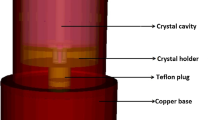Abstract
The impact of high-current pulsed relativistic electron beams on the way craters form in rock samples (granites and labradorite) is studied. The method of thermal-imaging monitoring is tested for quickly estimating the sample surface state and determining the insulating properties of geomaterials. It is shown that such complex experiments are appropriate for investigating rock properties, which are of utmost importance in choosing places for radioactive waste disposal.
Similar content being viewed by others
References
V. V. Lopatin and E. N. Kamnev, “Underground Burial of Radiactive Waste,” Atom. Strateg., No. 1 (2004).
I. L. Komov, Radiation Mineralogy and Geochemistry (Naukova Dumka, Kiev, 2006) [in Russian].
V. I. Mal’kovskii and A. A. Pek, “Permeability of Crack-Porous Medium with Regular System of Parallel Non-communicated Cracks,” Petrologiya 2(6) (1994).
V. M. Shmonov, V. M. Vitovtova, and A. V. Zharikov, Fluide Permeability of Earth’s Crust Rocks (Nauchn. Mir, Moscow, 2002) [in Russian].
A. N. Nikitin et al., “On Some Mechanisms of Permeability of Rocks Connected with Geoecological Safety of High Radiactive Waste Storages,” in Geophysical Investigations, ” Collected Vol. of Science Works, Int. Fiz. Zemli RAN (IFZ Ross. Akad. Nauk, Moscow, 2006), No. 6, pp. 85–95 [in Russian].
V. I. Mal’kovskii and A. A. Pek, “Influence of an Unconnected Fracture System on the Average Permeability of Rocks for a Regular Corridor Pattern of Isolated Cracks,” Petrologiya 13(2) (2005) [Petrology 13, 187 (2005)].
L. V. Makhlaev, “What do Mineral Composition of Granite Depends From,” Soros. Obrazov. Zh., No. 11 (1998).
D. O. Braien, R. Greivs, V. D. Zvorykin, et al., “Interaction of Pulse SO and SO2 Lasers with Rocks, Characteristic for Oil Occurence: Substance Carry-over and Recoil Pulse,” Fiz. Khim. Org. Mater., No. 2, 16–26 (2004).
V. V. Kashtanov and A. V. Saprykin, “Generation of Power Electric Pulses,” Teor. Fiz., No. 8, 188–200 (2007).
V. T. Uvarov et al., “Production of High Accurate Beams of Microsecond Time with High Efficiency,” Preprint KhFTI 84-30 (TsNIIatominform, Moscow, 1984).
D. O. Braien et al., “Interaction of Pulse SO and SO2 Lasers with Rocks, Characteristic for Oil Occurence: II. Gasodynamic Processes at Laser-Induced Ablation and Transformation of IR-Spectra of Absorption and Reflection of Rocks,” Fiz. Khim. Org. Mater., No. 1, 47–55 (2005)
V. S. Popov, “How Do Granites Formed,” Soros. Obrazovat. Zh., No. 6, 64–69 (1997).
S. S. Batsanov, B. A. Demidov, and L. I. Rudakov, “Using of High Accurate REP for Structure Transformations Realisation,” Pis’ma Zh. Eksp. Teor. Fiz. 30, 611–613 (1979) [JETP Lett. 30, 575 (1979)].
S. Schiller, U. Heisig, and S. Panzer, Electron Beam Technology (Wiley, New York, 1982; Naukova Dumka, Kiev, 1980).
Ya. B. Zeldovich and Yu. P. Raizer, Physics of Shock Waves and High-Temperature Hydrodynamic Phenomena (Nauka, Moscow, 1963) [in Russian].
N. I. Bazaleev et al., “Radiation Estimation Methods of Risks of Radiactive Waste Burials in Rocks,” Energetika. Ekonom., Tekhnol., Ekol. Nauk. Zh. NTU KPI, No. 2(21), 75–81 (2007).
V. V. Uvarov et al., “Processes of Mass Transfer in Rocks Examples under the Action of High Accurate Electron Beams,” in Proc. of the XX Intern. Symp. on Charged Particles Accelerators (Alushta, 2007), pp. 170–171.
N. I. Bazaleev et al., “Remote IR-Radiometrical Study of Open Kimberlite Bodies,” Preprint No. USSR, FTINT AN (1980).
N. I. Bazaleev et al., “Application of Remote IR-Survey for Geological Mapping, Search of Oil-Gas Structures, Kimberlite Bodies and Economical Estimation of its Using Perspectives,” in Thermal Fields of the Earth, Collected vol. (Makhachkala, 1979) [in Russian].
Author information
Authors and Affiliations
Additional information
Original Russian Text © N.I. Bazaleev, B.B. Banduryan, T.I. Ivankina, V.F. Klepikov, V.V. Lytvynenko, Yu.F. Lonin, A.N. Nikitin, A.G. Ponomarev, V.N. Robuk, V.V. Uvarov, V.T. Uvarov, 2009, published in Pis’ma v Zhurnal Fizika Elementarnykh Chastits i Atomnogo Yadra, 2009, No. 5 (154), pp. 684–693.
Rights and permissions
About this article
Cite this article
Bazaleev, N.I., Banduryan, B.B., Ivankina, T.I. et al. Simulating the radiation transformations in rocks-potential media for radioactive waste disposal. Phys. Part. Nuclei Lett. 6, 417–423 (2009). https://doi.org/10.1134/S1547477109050100
Published:
Issue Date:
DOI: https://doi.org/10.1134/S1547477109050100



